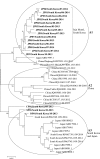Phylogenetic Analysis of Severe Fever with Thrombocytopenia Syndrome Virus in South Korea and Migratory Bird Routes Between China, South Korea, and Japan
- PMID: 26033016
- PMCID: PMC4559681
- DOI: 10.4269/ajtmh.15-0047
Phylogenetic Analysis of Severe Fever with Thrombocytopenia Syndrome Virus in South Korea and Migratory Bird Routes Between China, South Korea, and Japan
Abstract
Severe fever with thrombocytopenia syndrome (SFTS) is a tick-borne viral disease. The SFTS virus (SFTSV) has been detected in the Haemaphysalis longicornis, which acts as a transmission host between animals and humans. SFTSV was first confirmed in China in 2009 and has also been circulating in Japan and South Korea. However, it is not known if a genetic connection exists between the viruses in these regions and, if so, how SFTSV is transmitted across China, South Korea, and Japan. We therefore hypothesize that the SFTSV in South Korea share common phylogenetic origins with samples from China and Japan. Further, we postulate that migratory birds, well-known carriers of the tick H. longicornis, are a potential source of SFTSV transmission across countries. Our phylogenetic analysis results show that the SFTSV isolates in South Korea were similar to isolates from Japan and China. We connect this with previous work showing that SFTSV-infected H. longicornis were found in China, South Korea, and Japan. In addition, H. longicornis were found on migratory birds. The migratory bird routes and the distribution of H. longicornis are concurrent with the occurrence of SFTSV. Therefore, we suggest that migratory birds play an important role in dispersing H. longicornis-borne SFTSV.
© The American Society of Tropical Medicine and Hygiene.
Figures



Comment in
-
Can We Blame Migratory Birds for Transmission of the Emerging Severe Fever with Thrombocytopenia Syndrome Virus in East Asia?Am J Trop Med Hyg. 2015 Dec;93(6):1391-1392. doi: 10.4269/ajtmh.15-0524a. Am J Trop Med Hyg. 2015. PMID: 26657298 Free PMC article. No abstract available.
-
In Response.Am J Trop Med Hyg. 2015 Dec;93(6):1393. doi: 10.4269/ajtmh.15-0524b. Am J Trop Med Hyg. 2015. PMID: 26657299 Free PMC article. No abstract available.
References
-
- Yu XJ, Liang MF, Zhang SY, Liu Y, Li JD, Sun YL, Zhang L, Zhang QF, Popov VL, Li C, Qu J, Li Q, Zhang YP, Hai R, Wu W, Wang Q, Zhan FX, Wang XJ, Kan B, Wang SW, Wan KL, Jing HQ, Lu JX, Yin WW, Zhou H, Guan XH, Liu JF, Bi ZQ, Liu GH, Ren J, Wang H, Zhao Z, Song JD, He JR, Wan T, Zhang JS, Fu XP, Sun LN, Dong XP, Feng ZJ, Yang WZ, Hong T, Zhang Y, Walker DH, Wang Y, Li DX. Fever with thrombocytopenia associated with a novel bunyavirus in China. N Engl J Med. 2011;364:1523–1532. - PMC - PubMed
-
- Bouloy M. Molecular biology of phleboviruses. In: Plyusnin A, Elliot RM, editors. Bunyaviridae, Molecular and Cellular Biology. Norfolk, United Kingdom: Caister Academic Press; 2011. pp. 95–128.
-
- McMullan LK, Folk SM, Kelly AJ, MacNeil A, Goldsmith CS, Metcalfe MG, Batten BC, Albariño CG, Zaki SR, Rollin PE, Nicholson WL, Nichol ST. A new phlebovirus associated with severe febrile illness in Missouri. N Engl J Med. 2012;367:834–841. - PubMed
Publication types
MeSH terms
LinkOut - more resources
Full Text Sources
Other Literature Sources

